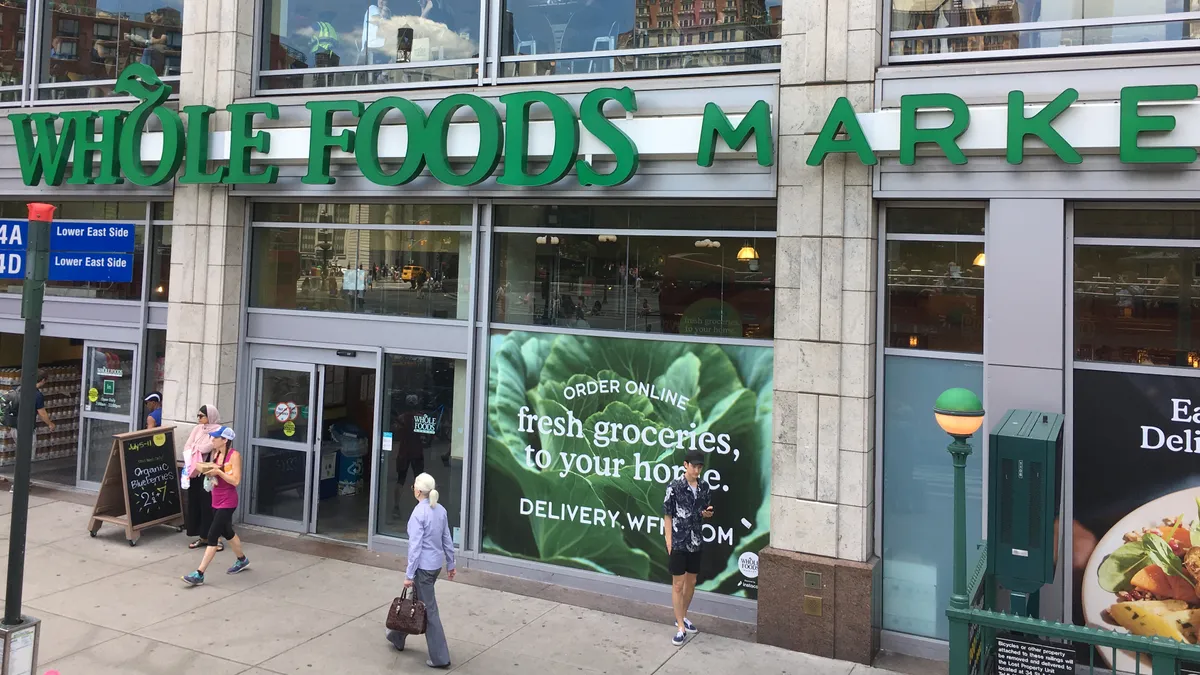Dive Brief:
- In a report regarding how to survive the retail apocalypse, CB Insights noted more grocers are investing in last mile logistics to provide the best grocery home delivery services.
- For some grocers such as Aldi and Target, that means acquiring personalized grocery delivery startups like Instacart and Shipt.
- But according to a recent survey conducted by YouGov and GT Nexus, 59% of more than 6,000 consumer respondents said they want full visibility of the grocery supply chain, suggesting that visibility of groceries in transit might be a critical aspect of home delivery.
Dive Insight:
Online sales of groceries are growing quickly and are expected to eat 20% of all grocery sales by 2025, so traditional grocers that ignore their online presence and home delivery services may be missing an important opportunity to differentiate themselves from cheaper, discount grocers and retain their customer base.
GT Nexus Vice President of Marketing Greg Kefer told Supply Chain Dive if grocers are going to offer groceries online then deliver to private homes, they'll need to provide some kind of end-to-end visibility for the consumer.
If consumers aren't going to the grocery store to inspect products before purchasing, they need a guarantee from the grocer and its 3PL that the groceries are in good shape and won't be compromised in transit.
The ride-sharing industry has already picked up on consumers' need for visibility. Uber provides a map tracking its customers' rides so they can see how close they are to their destination, or how far away their driver is.
"If Uber can do it, why can’t Safeway do it?" Kefer said.
According to the survey results, 80% of consumers will switch brands if their bought goods aren't delivered on time or if they don't have the desired level of visibility of bought goods in transit.
"We've known for decades that bad supply chain performance can be a brand killer," Kefer said.
"If Mrs. Smith received an order of bananas that was all black, whose fault is that, the grocery store or the delivery person? If you have a sensor, you could have the data to determine that."

Greg Kefer
GT Nexus Vice President of Marketing
One solution is blockchain — Walmart announced it could trace mangos from farm to shelf with blockchain in 2.2 seconds. The difficulty there is figuring out how not to overshare sensitive information with the consumer. Another potential solution is IoT sensors attached to packages to provide the grocers, 3PLs and consumers with real-time data on the condition of groceries in last mile transit.
"You could attach IoT sensors to the packaging that could keep track of temperature, light humidity and shock," Kefer said. "You could also get data on the condition of the product. Obviously if Mrs. Smith received an order of bananas that was all black, whose fault is that, the grocery store or the delivery person? If you have a sensor, you could have the data to determine that. From an operational perspective, that’s attractive."
But IoT sensors and delivery startups are only one piece of the grocery delivery puzzle. Neither Kefer nor Michael Witty, ISG's Director of Retail and CPG Digital Practice, believe large distribution centers will serve grocers well in the e-commerce age.
"Amazon didn’t acquire Whole Foods because of their storefronts. They acquired Whole Foods because they acquired a perishable supply chain, to support Amazon Prime grocery," Witty told Supply Chain Dive. "What they really acquired was regional distribution centers to get to the last mile."
While grocery's cold chain could benefit from more visibility, especially in the last mile to satisfy consumers, it could also benefit from microfulfillment, or subletting distribution space, closer to consumers to help prevent spoilage.
"Subletting warehouse space is a short term solution, potentially," Witty said. "If you go to any of the major grocers, they have a network of major distribution centers. The challenge is doing individual home delivery from there."
Witty said it would be smarter for grocers to do what Amazon is doing with Whole Foods by dedicating part of their brick-and-mortar grocery stores to individual home delivery distribution.
In short, solving the last mile for grocery delivery is a lot more complicated than just acquiring grocery delivery startups to take care of it. Because of the sensitivity of the products, consumers want more visibility, and grocers need to be close to the consumer. Supply chain technology can help, but there's still a lot of work to be done.














